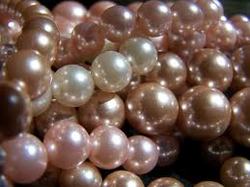 Cultured pearls are an extraordinary collaboration between man and mollusk. The Japanese have been culturing pearls since the 1880’s. That is to say man has helped the oysters produce pearls. At first they did mabe pearls, ones grown against the shell. in 1928 the first commercial crop of round pearls were harvested. The process that produces a saltwater cultured pearl is a long and involved one, but it clearly demonstrates the value of this beautiful gem.
Cultured pearls are an extraordinary collaboration between man and mollusk. The Japanese have been culturing pearls since the 1880’s. That is to say man has helped the oysters produce pearls. At first they did mabe pearls, ones grown against the shell. in 1928 the first commercial crop of round pearls were harvested. The process that produces a saltwater cultured pearl is a long and involved one, but it clearly demonstrates the value of this beautiful gem.Baby oysters, called spat, are farmed to a certain age then they are put in cages and put into the sea. They are fed with tubes near the cages and cleaned every three weeks to get rid of barnacles. The oysters must also be moved with the tides and to avoid red tides, a problem caused by pollution. When they are three years old the oysters are nucleated with a piece of shell, usually from a mollusk found in the Mississippi River, that is sent to Japan and cut into different size spheres. The pearl farmers must choose a donor oyster to use for the mantle tissue, the part of the oyster that makes a pearl. This tissue is cut into cubes and surgically implanted with the shell nucleus into other oysters’ foot or gonad. This surgical process must be carried out within twenty minutes removing them from the water. The color of the pearl is determined by the shell color of the donor oyster. Up to three pearls may be grown in one oyster, although better pearls are produced when only one is grown in an oyster.
Again the oysters are put in cages and put into the sea, where they are fed, cleaned and moved for one to three years. One in three oysters will die and only one in four will produce a pearl.
At the end of the growing process, the oysters are opened and the pearls removed. The cultured pearls are then sorted by size, color, roundness, and surface complexion. It takes sorting through 10,000 pearls to make one eighteen inch necklace. The pearls are drilled and strung on “hanks” and are sold to stringers who string them on silk with a clasp.
And thus, man’s collaboration with nature truly produces a jewel of the sea.
Photo by seiyastock :devseiyastock:


